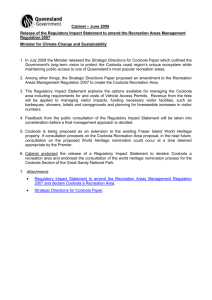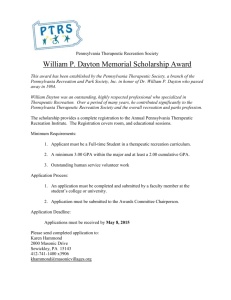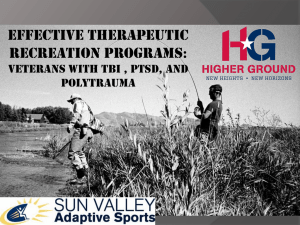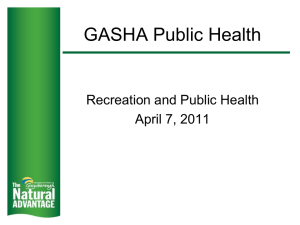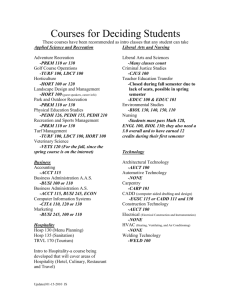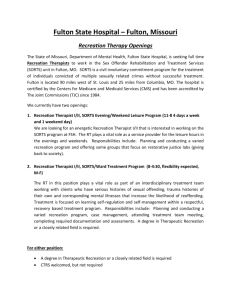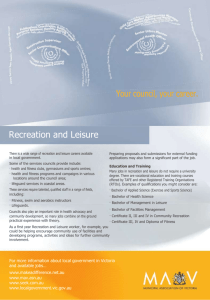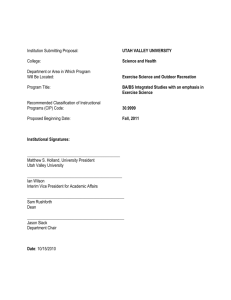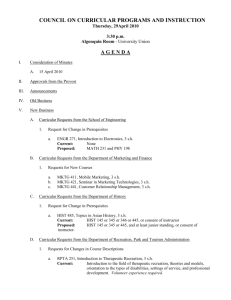Recreation Therapist
advertisement
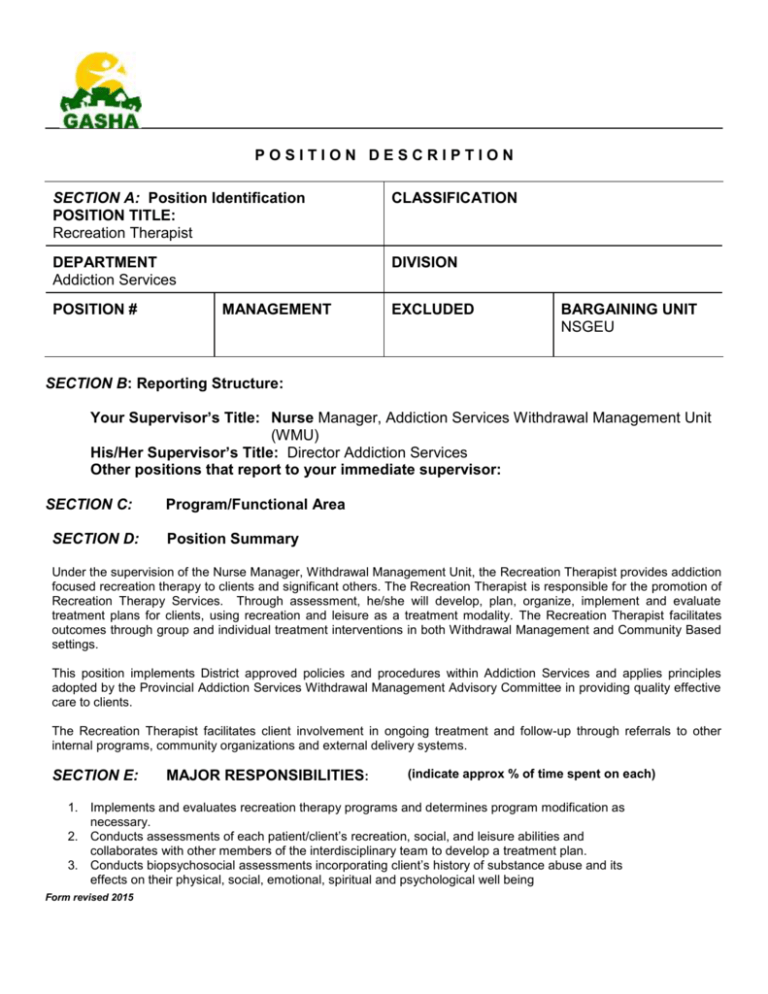
POSITION DESCRIPTION SECTION A: Position Identification POSITION TITLE: Recreation Therapist CLASSIFICATION DEPARTMENT Addiction Services DIVISION POSITION # MANAGEMENT EXCLUDED BARGAINING UNIT NSGEU SECTION B: Reporting Structure: Your Supervisor’s Title: Nurse Manager, Addiction Services Withdrawal Management Unit (WMU) His/Her Supervisor’s Title: Director Addiction Services Other positions that report to your immediate supervisor: SECTION C: SECTION D: Program/Functional Area Position Summary Under the supervision of the Nurse Manager, Withdrawal Management Unit, the Recreation Therapist provides addiction focused recreation therapy to clients and significant others. The Recreation Therapist is responsible for the promotion of Recreation Therapy Services. Through assessment, he/she will develop, plan, organize, implement and evaluate treatment plans for clients, using recreation and leisure as a treatment modality. The Recreation Therapist facilitates outcomes through group and individual treatment interventions in both Withdrawal Management and Community Based settings. This position implements District approved policies and procedures within Addiction Services and applies principles adopted by the Provincial Addiction Services Withdrawal Management Advisory Committee in providing quality effective care to clients. The Recreation Therapist facilitates client involvement in ongoing treatment and follow-up through referrals to other internal programs, community organizations and external delivery systems. SECTION E: MAJOR RESPONSIBILITIES: (indicate approx % of time spent on each) 1. Implements and evaluates recreation therapy programs and determines program modification as necessary. 2. Conducts assessments of each patient/client’s recreation, social, and leisure abilities and collaborates with other members of the interdisciplinary team to develop a treatment plan. 3. Conducts biopsychosocial assessments incorporating client’s history of substance abuse and its effects on their physical, social, emotional, spiritual and psychological well being Form revised 2015 4. Collaborates with the team members to facilitate client involvement in ongoing treatment and follow-up care. This may be done through referrals to other internal programs, community organizations as well as external delivery systems. 5. Documents relevant, current and accurate client treatment information in the patient chart and/or ASsist software. 6. Participates in interdisciplinary team conferences and family conferences as necessary. 7. Collaborates with other team members regarding program related issues. 8. Plans and implements outings for patients as appropriate as per established procedures. 9. Acts as a resource person to staff regarding Therapeutic Recreation needs for patients/clients. 10. Participates in interdisciplinary, departmental and professional development to ensure awareness of current developments of evidence based therapeutic recreation practice. 11. Provides instruction, supervision and evaluation of students as required. 12. Performs other related duties as assigned. POSITION SPECIFICATIONS SECTION F: ● MINIMUM FORMAL EDUCATION: Bachelor of Recreation specializing (Major) in Therapeutic Recreation SECTION G: CERTIFICATION/REGISTRATION/DESIGNATION: Certified Therapeutic Recreation Specialist by the National Council for Therapeutic Recreation Recertification SECTION H: ● ● ● ● ● A demonstrated professional and clinical knowledge base, effective integration of personal and professional qualities, and a comprehensive range of clinical skills appropriate to the field of addictions are essential. To ensure a treatment team that is able to competently address the needs of all target populations within the coverage area, the required clinical knowledge and skill base may, at times, need to be more specific and/or specialized, i.e. adolescents, seniors, women, first nations people. A well developed and demonstrated ability to work cooperatively and collaboratively with other professionals, paraprofessionals and lay persons is essential. A sound working understanding of a community health approach and community service delivery systems is necessary. Strong leadership abilities and an ability to function effectively as a clinical reference for other team members are required. SECTION I: ● ● ● ● ● JUDGEMENT & INITIATIVE: Required adherence to and modelling of professional confidentiality, legal requirements, treatment standards and expectations and professional codes of ethics. Routinely assumes primary clinical initiative in the development and implementation of the clinical direction with each client. Competently demonstrates an ability to critically analyze relevant information quickly, accurately and clearly to determine the level of functioning and severity of the problem(s). Demonstrates a high degree of professional judgment and guidance in collaborating with para professional colleagues regarding treatment concerns. Determines innovative selection and application of appropriate professional intervention/treatment models of practice which may maximize the efficient and effective use of available human resources. SECTION J: Form revised 2015 NATURE AND EXTENT OF CONTACTS: a) b) Within Organization(s) Contacts in person, by correspondence and telephone with personnel in various facilities/programs. Requires diplomacy and a clear understanding of procedures and mandate. Outside Organization(s) Contacts in person, by correspondence and telephone with the public at large, clients, education, medical and legal professionals, employers, other agencies and organizations, the business community and the media. Requires diplomacy, sensitivity and a clear understanding of procedures, mandates and lines of communication. SECTION J: ● ● ● ● TYPE AND LEVEL OF SUPERVISION EXERCISED: To participate, as required, in peer supervision activity. May be required to provide team leadership functions and to assist in evaluation of the results. Required to demonstrate a high degree of professional judgement and guidance in collaborating with professional and para professional colleagues regarding treatment concerns. May be required to chair, co-chair internal committees/task forces/focus groups. SECTION K: KEY RELATIONSHIPS: SECTION L: DEGREE OF RESPONSIBILITY FOR DECISIONS AFFECTING COSTS/RESPONSIBILITY FOR EQUIPMENT AND MATERIALS a) Direct Responsibility Determines innovative selection and application of appropriate professional intervention/treatment models of practice which may maximize the efficient and effective use of available human resources. Prevents costly intervention through use of appropriate and sound clinical assessment skills and judgement. Makes appropriate selection of audio visual and other educational program materials as well as appropriate therapeutic interventions/techniques so as to avoid potential costly liability. b) Indirect Responsibility Day to day observation and reporting of situations which may potentially jeopardize the safety and security of both clients and staff. SECTION M: ● ● ● ● The constant processing of clients traumatic experiences and intensity of feelings involved in the therapeutic process leads to an accumulative effect of work related stress. The demand for vigilance and analysis of legal and ethical responsibilities is complicated by the need to balance the demands of the system with the demands of the treatment relationship. Pressures of extended hours and after hour interventions may result in high stress. Vigilance regarding the potential for accusations such as sexual assault, discrimination, and exploitation is constantly required. SECTION N: ● ● ● ● PHYSICAL, MENTAL & VISUAL DEMAND: WORKING ENVIRONMENT and UNAVOIDABLE HAZARDS: Shift work is required as well as participation in a rotating schedule. Hostile/aggressive/impaired clients may present a risk/threat of physical/emotional harm. Potential for abusive phone calls, threats and personal/property damage. Client population is high risk category for HIV and Hepatitis. Form revised 2015 ● May be required to work with resistant and/or clients mandated into treatment. SECTION O: SAFETY (patient, worker & workplace): Commit to maintain and protect patient, client and personal safety on an ongoing basis. Annually access the training and education on patient, client and personal safety made available by GASHA. Prepared by: Date: Signature Name (please print) Approved by: Date: Signature Name (please print) VP Approval: Date: Signature Name (please print) DISTRIBUTION: Human Resources Services Department Form revised 2015

